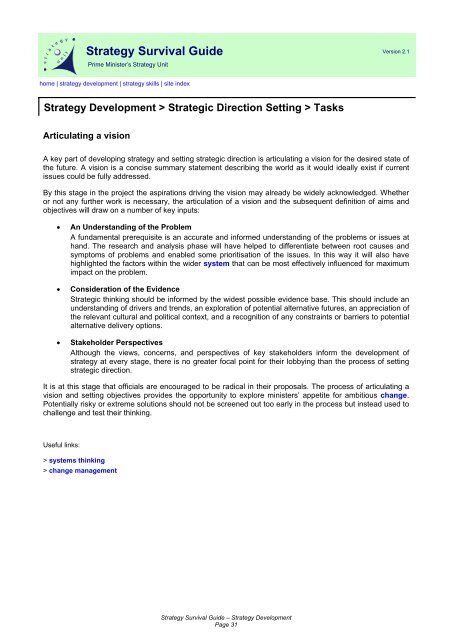Strategy Survival Guide
Strategy Survival Guide
Strategy Survival Guide
You also want an ePaper? Increase the reach of your titles
YUMPU automatically turns print PDFs into web optimized ePapers that Google loves.
<strong>Strategy</strong> <strong>Survival</strong> <strong>Guide</strong> Version 2.1<br />
Prime Minister’s <strong>Strategy</strong> Unit<br />
home | strategy development | strategy skills | site index<br />
<strong>Strategy</strong> Development > Strategic Direction Setting > Tasks<br />
Articulating a vision<br />
A key part of developing strategy and setting strategic direction is articulating a vision for the desired state of<br />
the future. A vision is a concise summary statement describing the world as it would ideally exist if current<br />
issues could be fully addressed.<br />
By this stage in the project the aspirations driving the vision may already be widely acknowledged. Whether<br />
or not any further work is necessary, the articulation of a vision and the subsequent definition of aims and<br />
objectives will draw on a number of key inputs:<br />
• An Understanding of the Problem<br />
A fundamental prerequisite is an accurate and informed understanding of the problems or issues at<br />
hand. The research and analysis phase will have helped to differentiate between root causes and<br />
symptoms of problems and enabled some prioritisation of the issues. In this way it will also have<br />
highlighted the factors within the wider system that can be most effectively influenced for maximum<br />
impact on the problem.<br />
• Consideration of the Evidence<br />
Strategic thinking should be informed by the widest possible evidence base. This should include an<br />
understanding of drivers and trends, an exploration of potential alternative futures, an appreciation of<br />
the relevant cultural and political context, and a recognition of any constraints or barriers to potential<br />
alternative delivery options.<br />
• Stakeholder Perspectives<br />
Although the views, concerns, and perspectives of key stakeholders inform the development of<br />
strategy at every stage, there is no greater focal point for their lobbying than the process of setting<br />
strategic direction.<br />
It is at this stage that officials are encouraged to be radical in their proposals. The process of articulating a<br />
vision and setting objectives provides the opportunity to explore ministers’ appetite for ambitious change.<br />
Potentially risky or extreme solutions should not be screened out too early in the process but instead used to<br />
challenge and test their thinking.<br />
Useful links:<br />
> systems thinking<br />
> change management<br />
<strong>Strategy</strong> <strong>Survival</strong> <strong>Guide</strong> – <strong>Strategy</strong> Development<br />
Page 31
















